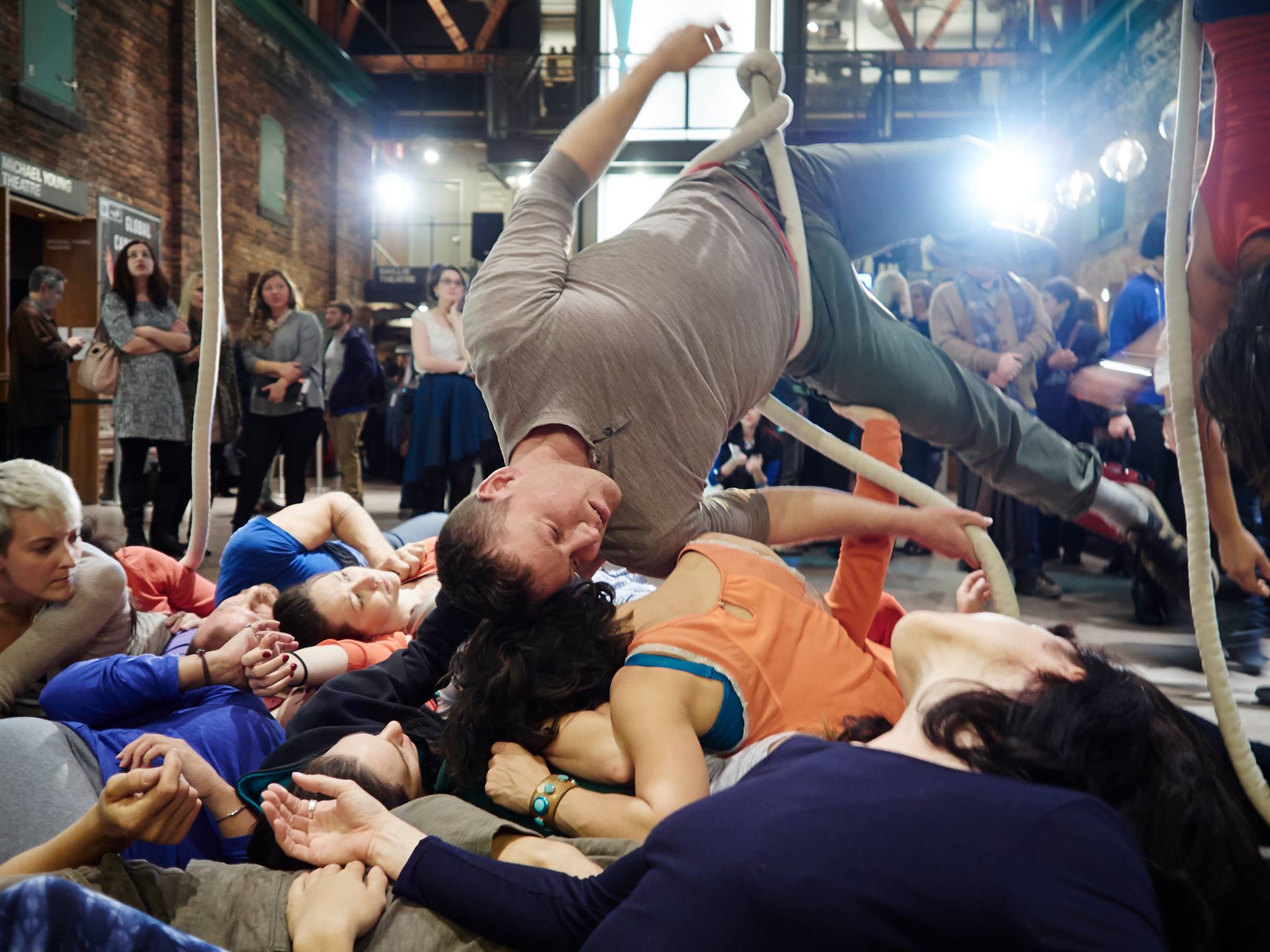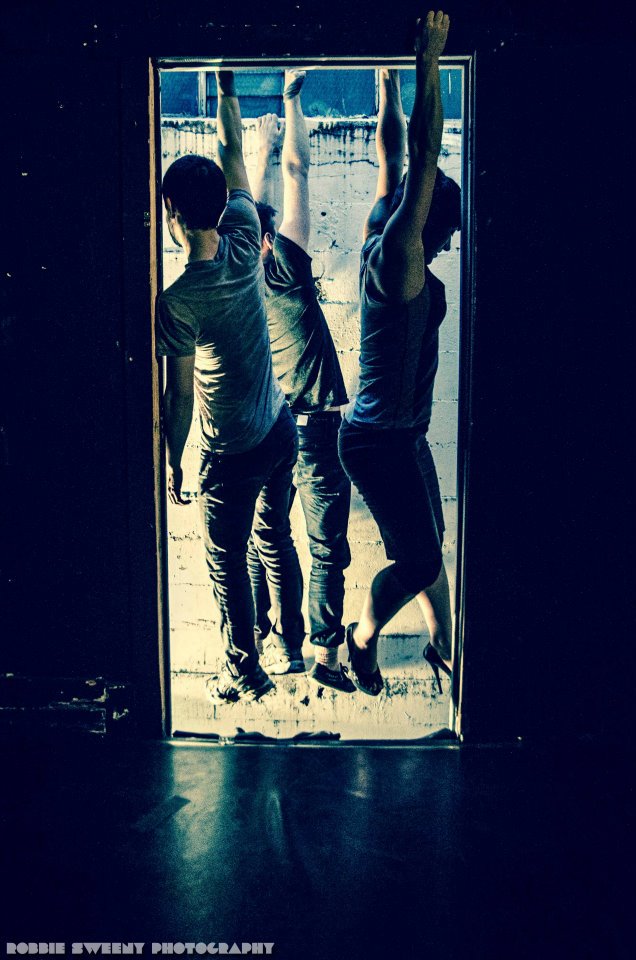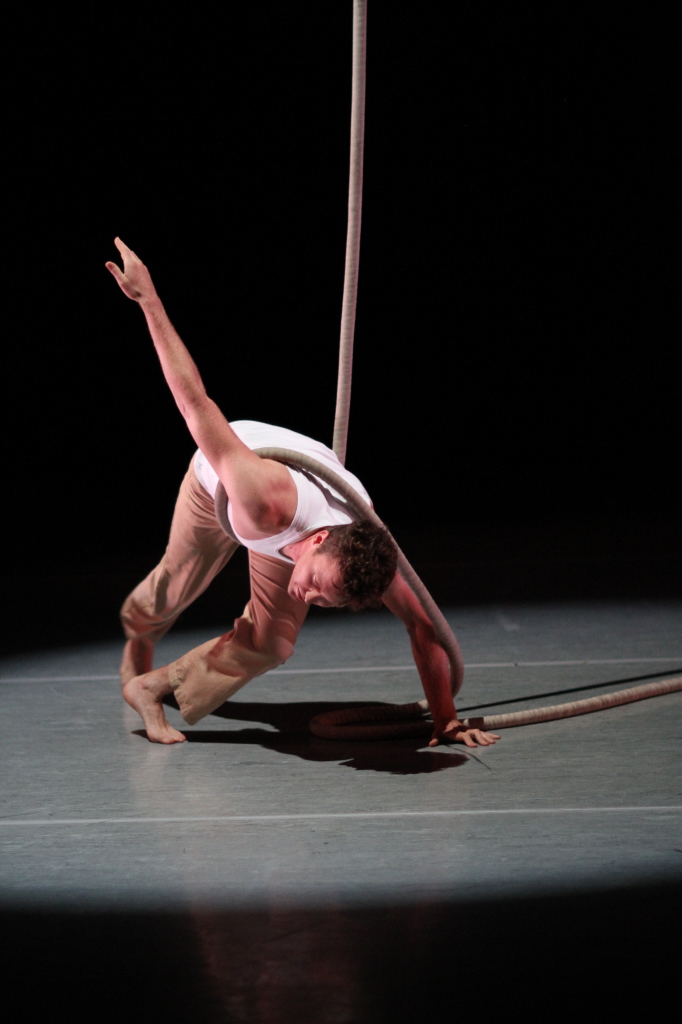Hanging Sphere
Analysis of the Hanging Sphere
Muscular Support for the Shoulder, Spinal Mechanics and Tensegrity Principles
authored by: Kevin O’Connor Sept. 14, 2010
edited by F. Faust
In 2001 in Amsterdam, I was fortunate enough to take a workshop with Frey Faust, the originator of the Axis Syllabus. This was my first introduction to the study of applied biomechanics. Shortly after, I was accepted into the National Circus School of Montreal where I specialized on the Spanish Web (hanging rope). This initial workshop inspired me to constant inquest and research, and has provided me with an invaluable tool for maintaining my health during the rigorous pedagogical process in the circus school environment. It has also greatly influenced my interest in finding ways to link the vertical sphere to the horizontal sphere through movement. In the following article I will outline what I feel are essential techniques for creating optimal support and safety for movement in the hanging sphere.
The circumstance of being on the rope is described as working in the “hanging sphere”, one of the terms used in the Axis Syllabus classification system to describe the postural relationships to a supportive surface. The five spheres of activity are as follows:
Sphere 1. Reclining
Primary support via more than one major body mass, i.e. Two or more main body masses giving most of their weight to the supportive surface.
Sphere 2. Sitting
One main body mass on the floor, the other main masses piled on this one, with or without additional support from peripheral support elements.
Sphere 3. Crouching
Main body masses give most of their weight to distal aspects of peripheral support elements. These distal elements (lower leg, heel, lower arm, hand) are placed between main body masses and the support surfaces.
Sphere 4. Standing
Main body masses are resting on proximal aspects of peripheral support elements (hip or shoulder-joints). Implying that distal aspect of peripheral support elements are in contact with the support surfaces
Sphere 5. Hanging
Main body masses suspended from a base of support above the body’s centre of mass, with decompression of joints due to the elastic structure of the body and the pull of gravity (hanging, swinging, pulling from the arms and legs). Sphere 5 seems to be defined by the use of the arms and legs that grapple a superior base of support.
According to current anthropological evidence, the evolution of human locomotion behaviour was strongly influenced by the arboreal phase of our distant ancestors. Moving within the hanging sphere can therefore be considered fundamental to our physiological development. In fact, climbing and hanging uses the same musculo-skeletal and nervous systems that allow us to walk.
The following passage describes the principle of locomotion in the context of hanging. While we are climbing, we are able to move forward by using first one support system and then another (i.e. one hand after the other). The asymmetry implied by this kind of sequential support deployment allows for the loss of equilibrium which generates the kinetic energy for efficient motion. In the standing sphere, the loss and recapture of equilibrium is visible in a toppling and repulsion activity; whereas, in the hanging sphere, it is visible in swinging and tugging.
In order to harness the kinetic energy set free through disequilibrium, the flexible system of bones and soft tissues provide tension through-lines that create an elastic, adaptive stability or “tensegrity”. These through-lines are established by the web of fascial membranes that envelop all the structures in the body. The musculo-fascial systems pertinent to our discussion of climbing include:
A. Over the back:
flexor digiti longus/brevis, carpi ulnaris, brachialis, triceps, teres twins, latisimus dorsai, quadratus lumborum, sacrotubural ligament, biceps femoris, peroneous group, and the tibialus anterior/posterior
This system biforcates at the iliac crest running across the glutius maximus and into the vastus group, the sartorius, the popliteous, and hitches into the peroneous group at the fibular head.
B. Over the front:
-thenar, forearm, biceps, deltoids, rotator cuff muscles, seratus anterior and the perctorals, intercostals, external obliques, psoas, and the pectineous
This system communicates across the femur to the biceps femoris and on down.
Climbing on the vertical rope requires the maintenance of a healthy and strong shoulder or glenohumeral joint. Clues for the maintenance of the health of the shoulder are indicated in the range of motion parameters suggested by glenohumeral anatomy. Extremely pertinent to this discussion of the bio-mechanical limitations of the shoulder, are the relative sizes and facings of the humeral head and its articulating surface, the fossa glenoid.
The humeral head faces the shoulder on a medially oriented angle to the back and offers a synovial surface that is three times the size of the corresponding surface on the fossa glenoid. The fossa glenoid faces laterally on a diagonal to the front and is rimmed by jutting structures such as the scapular acromion and the corocoid process. The acromion and corocoid process provide support for the humerus in some cases, yet also represent limitations and the danger of luxation or impingement. The most supportive relationship this complex of structures can offer is created when the synovial surface of the humeral head is oriented to the fossa glenoid along the axis of the humeral neck. This is called the “shoulder axis” (SX) in biomechanics. This axis provides the criteria for safe movements i.e. flexion, extension, adduction, abduction, circumduction, rotation.
While we are climbing, the hands must be brought into a superior position to the head in order to grasp the rope. This means the arms must pass through a complete flexion. The SX will be described by an arcing movement that curves first medially and then laterally as the arm rises and is accompanied by an external rotation after approximately forty degrees of elevation. This movement has been demonstrated to maintain the femural head and fossa glenoid in their most supportive relationship. In this relationship the surrounding musculature can collaborate for optimal strength. The outward rotation of the humerus during elevation allows the hands to come together to grasp the rope with both thumbs facing upwards. This allows the medial hand to fulfill its role as primary support. One hypothesis is that the presence of the discus articularis in the medial side of the wrist offers support in compression (including hanging) situations.
The oblique, posteriorly tilted angle of the skeleton of the wrist brings the synovial surfaces of the carpal bones, the ulnar and the radius together. When articulating synovial bone surfaces are in alignment there is more potential support. “Alignment can be defined as the collaboration of the fascia, discs, muscles and bones to bring the surfaces of the joints together when managing torsion, compression and shearing forces. The evidence of alignment can be observed in the arching curves and moderate angles that are established when joints are at full support value” (F. Faust, AS reader, introduction p. 3)
While hanging, a total relaxation into the tendons and bones, or “dead hang”, can cause a dangerous detraction in the shoulder joint. By engaging the muscles that create compression, the health of the joint can be assured. Compression locks the joints together when there is proper alignment. Due to the large capacity for motion in the shoulder, it is also helpful to strengthen the stabilizing muscles. These include the rotator cuff (the supraspinatus, infraspinatus, teres minor, subscapularis) as well as pectoralis, deltoids and trapezius which surround the shoulder to provide additional strength and stability. The latissimus also supports the lower body when hanging from the hands. Other muscles designed to position the scapula for overhead movement are the trapezius (especially lower trapezius), and serratus anterior, with counterforces being produced by levator scapulae, rhomboids and the pectoralis minor muscles.
Shoulder joint pain is a common complaint for climbers. Raising the arm overhead causes the head of the upper humerus to rise slightly in the shoulder socket, and narrows the space between the head of the humerus and acromion This can cause impingement between the rotator cuff tendons and the roof of the shoulder blade. Repetitive overhead arm movement can therefore be said to cause repeated impingement and friction between the rotator cuff tendon and the undersurface of the acromion, and may cause irritation and inflammation of the tendon as well. This common kind of injury can be largely avoided through the observance of the shoulder axis.
Studies in Functional Movement on the Vertical Rope
Moving Upward Using Proximal Motor Compensation
Often when people first learn to climb the vertical rope they try to continuously pull themselves up from one arm to the next resulting in quick muscle fatigue. As one moves up on the vertical rope one passes weight from the feet to the hands. A typical initial ascent position; arms long and hands placed at a fixed point over head, legs piked to the rope in front of the body. The legs rest together extended in a pike position in front of the body with the rope wrapped around one ankle and squeezed between both feet in a hold (promises the potential to bear weight). As the climber transfers first the pelvis, then the torso and finally the head over his or her feet, their weight transfers from their hands to their feet. The sequential use of the body masses to generate kinetic energy revises the notion of those same masses as luggage, promoting them to motors. The three central masses, 1) the organ cavity and pelvis, 2) the lung-heart and rib-cage and 3) the neck and head, are called the Proximal Motors in the AS classification system.
The transfer from a hanging pike position to vertical standing position by way of proximal motor compensation sends the energy of the body into and up the rope. As the mass of the body moves over the feet, the hands are free to let go of the rope and reach higher up. The climber then hangs from their hands (without the need to pull up) and moves their foot hold further up the rope and repeats the steps described above.
Pendular Movement Around One Fixed Point
After one learns to ascend the rope the next step is is the study of methods for harness gravity to aid in movement on the rope. Here, once again, we can take our cue from nature. (“http://en.wikipedia.org/wiki/Brachiation”) Brachiation is a specialized form of arboreal locomotion, used by primates to moves very rapidly while hanging beneath branches. Arguably the epitome of arboreal locomotion, it involves swinging with the arms from one handhold to another. Numerous studies of Gibbon Great Apes have examined the pendulum-like behaviour of the gibbon
body swinging beneath a handhold while supported by a passive, stiff, arm. For us as well, the pendulum swing of the body around the hands is a prime conductor for movement. The swing allows us to harness the energy created by falling to move up the rope.
Within the hanging sphere, the pendular swing is of primary importance to progressive motion. During the swing there is usually a moment where we can find repose. This moment is characterized by an upside down, inverted position with the rope on one side of the hips, and is typically called the “resting point” (RP) by circus artists. Specifically, during the RP, the the body hangs upside down in an inverted straddle pike, in other words, the legs are open and folded so they rest horizontal to the ground with the knees facing down, while the hands reaching between the legs to grab the rope. The pelvis sits above the hanging support, in this case the hands, and the torso and head rest below it. The pendular motion of the body swinging down and to the other side of the rope starts with the legs rising so they rest in a slightly flexed position in relation to the pelvis. Once RP has been resolved, the pelvis, now positioned above the torso and the head, tips beyond it inertia moment and accelerates toward the ground. The arms stay in full extension with a slight bend in the elbow and the shoulders stabilized towards the rib-cage. This co-ordination allows the energy of the dropping pelvis to be harnessed into a upward swing, rather than scattering into the tendons and joints of the shoulders and elbows. Once generated, this kinetic thrust can be used to raise the head and torso to the upright position. The pelvis (from below T12) rotates along the horizontal axis and turns into the rope (so that one’s belly button always turns and faces the rope as one swings down). The dropping pelvis swings the legs forward. The legs gather momentum from the down-swing and kick up as the pelvis swings back up. The legs pull the pelvis back over the torso and the head on the other side of the rope. This pendular swing creates the momentum for the climber to hook one of their legs above their grasping hands and move up the rope.
Side Bending
The weight distribution phenomenon known as Side-Bending (SB) is an extremely important aspect of managing transitions within the hanging sphere. According to the Axis Syllabus research, optimal SB includes tri-axial, counter-rotational motions that maintain and make use of the neutral spinal curves for the displacement of central body-masses and the disposition of the arms and legs. SB is an integral part of the transition from a hanging position with the pelvis, torso and heading hanging below the grasping hands to the inverted RP with the pelvis resting above the hands and the torso and head hanging upside down below the grasping hands.


